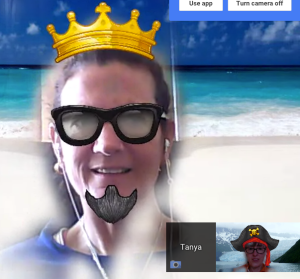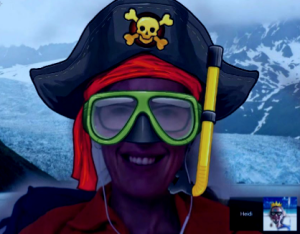This is a collaborative blog post written through the use of Google Docs by the #tiegrad Mendeley team including: Jarod, Jason, Tanya, Melody, myself, Liane, Harprit, Angela, and Mardelle.
Recently a group of us from #tiegrad logged into a Google Hangout session together (after a less than successful attempt to meet via Bluejeans) so that Jason Kemp could school us on Mendeley as a reference tool. In the past, we had each used a variety of reference tools with success, including EasyBib, Refworks through UVIC, EndNote, and Zotero, but many people were recommending other tools this fall and exploring some of them seemed like a good idea. A number of us found ourselves overwhelmed when looking at each of the options, however, and similar requests for help and information began to surface. Believing that Mendeley might be The One, a group of us emerged from the #tiegrad pool, all wanting to learn about this tool; we all boarded the collaboration train. If there is one thing we have learned about ourselves in this last year and a half, it’s the benefit of sharing the load and hashing things out together.
After posting a request out on Twitter from the group, Jason agreed to host a Mendeley sharing session. He admitted to being a bit nervous (as any of us would have been), as he had only recently made the switch to Mendeley himself. He explained that he was looking for a reference management software that was user-friendly and had obtained a copy of Endnote from a friend, but had difficulties using the program. Jason had used Mendeley briefly for another course, but this was only to create a bibliography.
We initially decided to meet up on Bluejeans for our Mendeley session, but soon after we logged on, we began experiencing major issues. As Jason was sharing his screen with the group, it became unresponsive. Unfortunately, Jason didn’t realize the participants could not see his screen and continued to proceed with the presentation while the audience, similarly, remained unaware for several minutes. This is a problem when presenting using a program such as Bluejeans to screenshare; it’s not always immediately apparent to either side that there is a problem. After several attempts to rectify the situation, we decided to switch over to Google Hangout (GHO). For many, it was their first time using GHO to present and we found it to be very slick and easy to use. After the presentation was finished, a few other members were able to share some of the features they had discovered (such as the chat window, screen captures, using accessories to dress each other up and other useful and entertaining tools). This was an awesome way to learn about GHO’s capabilities.
As many of us do when learning a new program, Jason had viewed a quick tutorial on YouTube and then began to play around and learn a few of the components of Mendeley. Jason noted that it was very intuitive and had an easy help option; these were features that many of us were looking for in a reference tool. Mendeley easily imports .pdfs, cites as you write in Microsoft Word, creates a bibliography for you, and allows sharing libraries between users. Check out the short, user friendly tutorials that can walk you through the basic functionality of Mendeley. Mendeley Minutes cover such topics as: importing topics, organizing your library, and how to use the group feature.
It is easy to get started on Mendeley. Simply sign up for an account, download the appropriate software, and then download the tool bar plug-in for Word. Mendeley trumps many other citation tools with its built-in Literature Search. As articles are curated, Mendeley suggests related articles based on key terms, authors, and tags. Mendeley will indicate whether the articles are available through its library, or directs you to where they can be found. Logging into your UVic Library account while searching makes it easy to copy and paste titles suggested by Mendeley into Google Scholar to acquire a found article. Your library builds quite quickly! Each article suggested by Mendeley comes with an additional list of suggested related articles to explore. The program then auto populated the information for referencing. There is also a Chrome extension tool that will allows for clipping articles directly into Mendeley which is very convenient.
Another Mendeley advantage is the fact that there are apps available so you can access the program on other devices and it syncs easily. Once an article is added on your computer, you can see it from any of your devices. Annotating articles using an iPad, for example, will update the article in your library, making all changes visible from any platform you choose to use. One #tiegrad lit review team has been using the group feature in Mendeley to successfully share articles. This feature works well for small groups, as it automatically syncs the articles to each member but, unfortunately, the group limit is 3 participants; adding more members requires paying a substantial membership fee.
In the end, our fabulous Mendeley Guide, Mr. Jason Kemp had us comfortably navigating our way through the world of online resource curation and citation. Mendeley has proven to be an efficient and effective tool that allows us to search, read, make notes, curate and cite our sources. It organizes our sources however we need, offers collaboration amongst colleagues (three maximum), and integrates beautifully into Microsoft Word making it easier to insert citations and create bibliographies as we progress through our lit reviews.
Our Google Hangout session was a success. It is nice to know that with so many of us using Mendeley, support and new ideas are only a tweet away. While the business end of our session was very productive, we also laughed and enjoyed our #tiegrad community. There is nothing better than dressing as a pirate or mixing and matching props and backgrounds online. The collaborative nature of Google Hangout offers a wonderful mix of business and play. Just remember, that only three microphones can be active at once. Perhaps this is something that Google can increase in the future. Are you listening Google?


